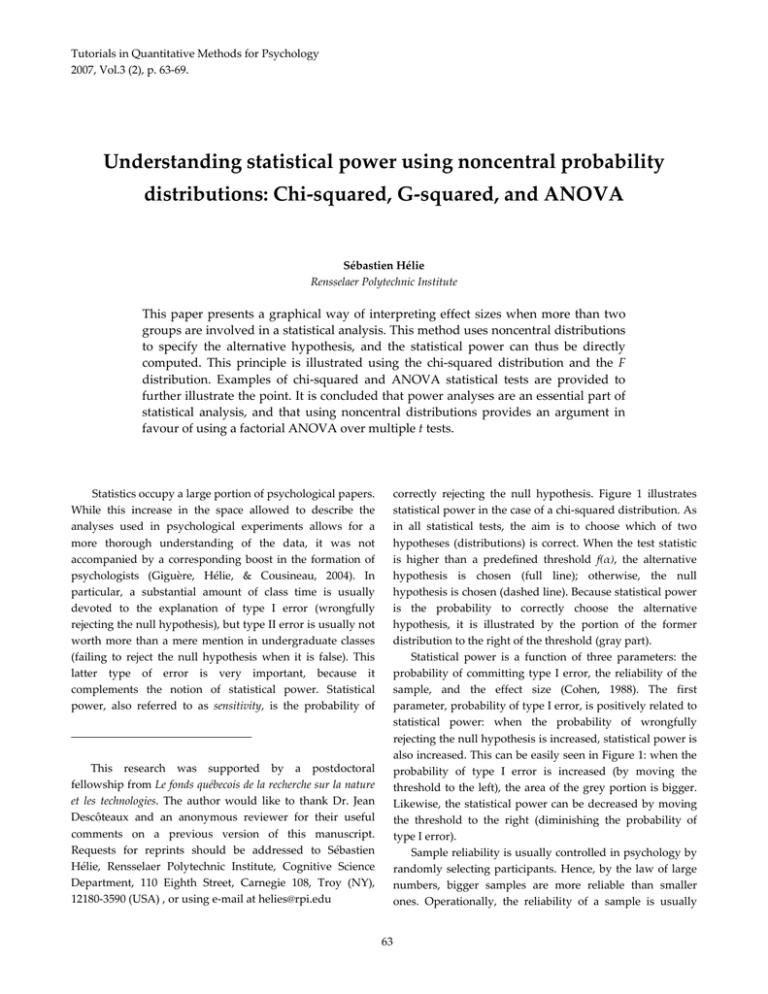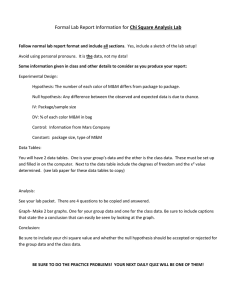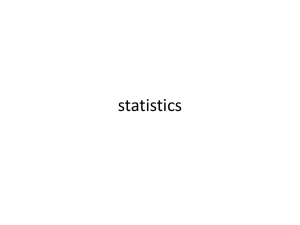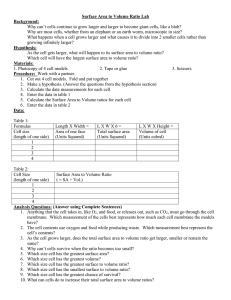an introduction to model selection: tools, algorithms, and thoughts
advertisement

Tutorials!in!Quantitative!Methods!for!Psychology!
2007,!Vol.3!(2),!p.!63"69.!
!"#$%&t("#)"*!&t(t)&t)+(,!-./$%!0&)"*!"."+$"t%(,!-%.1(1),)t2!
#)&t%)10t)."&3!45)"&60(%$#7!8"&60(%$#7!("#!9:;<9!
=>1(&t)$"!?>,)$!
Rensselaer!Polytechnic!Institute!
!
This! paper! presents!a! graphical! way! of! interpreting! effect! sizes!when! more! than! two!
groups!are!involved!in!a!statistical!analysis.!This!method!uses!noncentral!distributions!
to! specify! the! alternative! hypothesis,! and! the! statistical! power! can! thus! be! directly!
computed.! This! principle! is! illustrated! using! the! chi"squared! distribution! and! the! F!
distribution.! Examples! of! chi"squared! and! ANOVA! statistical! tests! are! provided! to!
further!illustrate!the!point.!It!is!concluded!that!power!analyses!are!an!essential!part!of!
statistical! analysis,! and! that! using! noncentral! distributions! provides! an! argument! in!
favour!of!using!a!factorial!ANOVA!over!multiple!t!tests.!
!
!
!
Statistics!occupy!a!large!portion!of!psychological!papers.!
While! this! increase! in! the! space! allowed! to! describe! the!
analyses! used! in! psychological! experiments! allows! for! a!
more! thorough! understanding! of! the! data,! it! was! not!
accompanied! by! a! corresponding! boost! in! the! formation! of!
psychologists! (Giguère,! Hélie,! &! Cousineau,! 2004).! In!
particular,! a! substantial! amount! of! class! time! is! usually!
devoted! to! the! explanation! of! type! I! error! (wrongfully!
rejecting!the!null!hypothesis),!but!type!II!error!is!usually!not!
worth! more! than! a! mere! mention! in! undergraduate! classes!
(failing! to! reject! the! null! hypothesis! when! it! is! false).! This!
latter! type! of! error! is! very! important,! because! it!
complements! the! notion! of! statistical! power.! Statistical!
power,! also! referred! to! as! sensitivity,! is! the! probability! of!
!!!!!!!!!!!!!!!!!!!!!!!!!!!!!!!!!!!!!!!! !!!!!!!!!!!!!!!!!!!!!!!!!
!
!
This! research! was! supported! by! a! postdoctoral!
fellowship!from!Le!fonds!québecois!de!la!recherche!sur!la!nature!
et! les! technologies.! The! author! would! like! to! thank! Dr.! Jean!
Descôteaux! and! an! anonymous! reviewer! for! their! useful!
comments! on! a! previous! version! of! this! manuscript.!
Requests! for! reprints! should! be! addressed! to! Sébastien!
Hélie,! Rensselaer! Polytechnic! Institute,! Cognitive! Science!
Department,! 110! Eighth! Street,! Carnegie! 108,! Troy! (NY),!
12180"3590!(USA)!,!or!using!e"mail!at!helies@rpi.edu!
correctly! rejecting! the! null! hypothesis.! Figure! 1! illustrates!
statistical!power!in!the!case!of!a!chi"squared!distribution.!As!
in! all! statistical! tests,! the! aim! is! to! choose! which! of! two!
hypotheses! (distributions)! is! correct.! When! the! test! statistic!
is! higher! than! a! predefined! threshold! f("),! the! alternative!
hypothesis! is! chosen! (full! line);! otherwise,! the! null!
hypothesis!is!chosen!(dashed!line).!Because!statistical!power!
is! the! probability! to! correctly! choose! the! alternative!
hypothesis,! it! is! illustrated! by! the! portion! of! the! former!
distribution!to!the!right!of!the!threshold!(gray!part).!
Statistical! power! is! a! function! of! three! parameters:! the!
probability! of! committing! type! I! error,! the! reliability! of! the!
sample,! and! the! effect! size! (Cohen,! 1988).! The! first!
parameter,!probability!of!type!I!error,!is!positively!related!to!
statistical! power:! when! the! probability! of! wrongfully!
rejecting!the!null!hypothesis!is!increased,!statistical!power!is!
also!increased.!This!can!be!easily!seen!in!Figure!1:!when!the!
probability! of! type! I! error! is! increased! (by! moving! the!
threshold!to!the!left),!the!area!of!the!grey!portion!is!bigger.!
Likewise,!the!statistical!power!can!be!decreased!by!moving!
the! threshold! to! the! right! (diminishing! the! probability! of!
type!I!error).!!
Sample!reliability!is!usually!controlled!in!psychology!by!
randomly! selecting! participants.! Hence,! by! the! law! of! large!
numbers,! bigger! samples! are! more! reliable! than! smaller!
ones.! Operationally,! the! reliability! of! a! sample! is! usually!
!
!
63!
!
!
!
ANOVAs)! or! entire! distributions! (e.g.,! chi"squared,! G"
squared).!For!instance,!the!null!hypothesis!when!performing!
an!ANOVA!is!that!the!variance!of!the!groups’!mean!is!zero.!
Likewise,! the! null! hypothesis! when! performing! a! chi"
squared! or! G"squared! test! is! that! the! variance! of! the!
proportions!is!zero.!In!both!cases,!this!can!only!be!achieved!
if!all!the!means!or!all!the!proportions!are!the!same,!and!the!
effect!size!can!be!best!understood!using!the!noncentral!chi"
squared! (chi"squared,! G"squared)! or! noncentral! F!
distributions! (ANOVA).! These! two! cases! are! now!
illustrated.!
!
Figure! 1.! Chi"squared! and! noncentral! chi"squared!
distributions.!The!former!represents!the!null!hypothesis!and
is! illustrated! using! the! dashed! line! (#! =! 5),! while! the! latter
represents!the!alternative!hypothesis!and!is!illustrated!using
the! full! line! (#! =! 5,! $! =! 5).! The! grey! portion! represents
statistical!power.!
45)"&60(%$#7!8"&60(%$#7!!
("#!t5$!"."+$"t%(,!+5)"&60(%$#!#)&t%)10t)."!
As!argued!earlier!and!shown!in!Figure!1,!hypotheses!in!
statistical! tests! are! usually! represented! using! distributions:!
the! test! statistics! measures! how! much! they! differ.! When!
performing! statistical! tests! using! the! chi"squared!
distribution,! the! alternative! hypothesis! is! not! usually!
represented;! only! the! null! hypothesis! is! (the! usual! chi"
squared! distribution),! and! the! threshold! found! in! a!
statistical! table! is! used! to! either! accept! or! reject! the! null!
hypothesis.! However,! when! performing! a! power! analysis,!
the!alternative!hypothesis!has!to!be!specified.!In!the!case!of!
the! chi"squared! and! the! G"squared! statistical! tests,! the!
alternative! hypothesis! is! a! noncentral! chi"squared!
distribution! (as! shown! in! Figure! 1).! This! distribution! is!
described!by:!
measured!using!the!standard!error!of!the!sample!mean:!
!
SEX "
s2
!
n
64!
(1)!
where! s2! is! the! unbiased! estimate! of! the! population’s!
variance,!and!n!is!the!sample!size.!It!is!easy!to!see!that!Eq.!1!
diminishes! when! the! sample! size! is! increased.! Because! test!
statistics! are! usually! scaled! using! standard! errors,!
decreasing!this!measure!increases!the!test!statistics,!and!thus!
the!statistical!power!of!the!test.!
The! last! parameter! that! affects! statistical! power! is! effect!
size,!which!directly!refers!to!the!proportion!of!the!change!in!
the! dependant! variable! that! can! be! attributed! to! the!
controlled!factor.!While!this!parameter!is!easy!to!interpret!in!
the!context!of!tests!that!compare!two!means!(e.g.,!the!scaled!
difference!between!the!means!in!a!t!test),!it!is!more!difficult!
to!understand!in!cases!involving!more!than!two!groups!(e.g.,!
p( x | 0 , 1 ) "
!
e
'
( x (1 )
2
0
x2
'1
0
2
2
#1x $k
&
%
k "0
0+
.
2 2 k k! /, k ( ) !
2*
-
(2)!
with! #! >! 0! degrees! of! freedom,! $! #! 0! is! the! noncentrality!
&
parameter,! and! / # x $ " 20 t x '1e 't dt ! is! the! Gamma! function.!
When!$!=!0,!Eq.!2!can!be!simplified!to:!
p( x |0 ,0) " p( x |0 )
0
!!!!!!!!!!!!!!!! "
'1 '
x2 e
x
2
0
0
(3)!
/ ., +) 2 2 !
-2*
which! is! the! usual! chi"squared! distribution! with! #! >! 0!
degrees! of! freedom.! The! smaller! the! value! given! to! $,! the!
bigger! the! overlap! between! the! null! and! alternative!
hypotheses.!On!the!other!hand,!the!bigger!the!value!given!to!
$! ,! the! smaller! the! overlap! and,! as! a! result,! the! higher! the!
statistical! power.! Figure! 2! illustrates! several! examples! of!
noncentral!chi"squared!distributions.!
Because! the! alternative! hypothesis! necessarily! has! the!
same!number!of!degrees!of!freedom!as!the!null!hypothesis,!
!
Figure! 2.! Noncentral! chi"squared! distributions! ($ =! 5)! with!
varying! %s.! The! filled! distribution! represents! a! null
hypothesis.! As! %! increases,! the! overlap! of! the! alternative
hypotheses! with! the! null! hypothesis! (grey! region)
diminishes.!!
!
!
!
65!
!
C5$!9:;<9!("#!t5$!"."+$"t%(,!D!#)&t%)10t)."!
all!that!is!needed!to!specify!the!alternative!hypothesis!is!an!
estimation! of! the! noncentrality! parameter! ($).! As! hinted!
As! in! the! chi"squared! and! G"squared! statistical! tests,!
earlier,!$!is!a!function!of!the!effect!size:!
only!
the! null! hypothesis! is! usually! represented! when!
1 " n 432 !
(4)!
!
performing!an!ANOVA!(a! F!distribution).!This!reluctance!to!
where! n! is! the! sample! size,! and! %! is! the! effect! size.! In! the!
illustrate!the!alternative!hypothesis!follows!from!a!difficulty!
case!of!a!chi"squared!or!a!G"squared!statistical!test,!the!effect!
to! interpret! the! effect! size,! which! is! related! to! the!
size!can!be!estimated!by:!
noncentrality!parameter!of!a!noncentral! F!distribution.!This!
k # H ' H $2
latter!distribution!is!described!by:!
0i
!
(5)!
!
3 " % 1i
H
1
1ux
i "1
0i
u v u
p( x |u, v , 1 ) " e
where!k!is!the!number!of!cells,!H0i!is!the!expected!proportion!
of! data! in! cell! i,! and! H1i! is! the! actual! proportion! of! data! in!
cell! i.! It! is! noteworthy! that! Eq.! 5! is! similar! to! the! formula!
used! to! compute! the! chi"squared! test! statistic,! except! that!
proportions!are!used!instead!of!frequencies.!
Once!the!effect!size!estimated,!the!statistical!power!of!the!
test!is!easily!computed:!
!
.x
+
power " 1 ' ,, 2 p( x | 0 , 1 ) dx ))
-0
*
f (5 )
!
' (
2 2# v ( ux $ 2 2 2 '1
u v x
4
u
!
( v ( ux)
'
(u( v)
2
'1 .
u
v
1ux + !
/ ., +) / ., 1 ( +) L2v , '
)
2*
2(
v
( ux) *
-2* -
(7)!
2
u v
u(v+
B ., , +) / .,
)
-2 2* - 2 *
where! u! >! 0! is! the! number! of! degrees! of! freedom! of! the!
tested! effect! (numerator),! v! >! 0! is! the! number! of! degrees! of!
freedom! of! the! error! term! (denominator),! %! #! 0! is! the!
noncentrality! parameter,! B( x , y) " / # x $ / # y $ / / # x ( y $ ! is! the!
usual!Beta!function,!and!
e x x ' k dn ' x n ( k
Lkn ( x) "
(e x ) !
!
n! dxn
is!a!generalized!Laguerre!polynomial.!Fortunately,!when!$!=!
0,!Eq.!7!is!simplified!to!the!usual!F!distribution:!
(6)!
where! the! term! in! parenthesis! is! the! cumulative! density!
function! of! the! noncentral! chi"squared! distribution! (Eq.! 2)!
evaluated! at! the! threshold! found! in! a! chi"squared! table! (!
f(")).!This!value!can!be!given!by!any!scientific!computation!
software! (e.g.,! Mathematica,! Matlab).! Listing! 1! presents! the!
Mathematica!code!to!compute!the!power!of!a!chi"squared!or!
G"squared!statistical!test.!
p( x |u, v ,0) " p( x |u, v)
u v u
!
'1
u 2 v 2 x 2 ( v ( ux)
!!!!!!!!!!!!!!!!!!! "
u v
B ., , +)
-2 2*
'
u( v
2
!
(8)!
Figure!3!shows!noncentral!F!distributions!with!different!$s.!
Like! the! noncentral! chi"squared! distribution,! an! increase! in!
the! value! of! the! noncentrality! parameter! diminishes! the!
overlap!between!the!null!and!alternative!hypotheses,!which!
in!turn!increases!the!statistical!power.!
Because!the!alternative!hypothesis!has!the!same!number!
of! degrees! of! freedom! as! the! null! hypothesis,! only! the!
noncentrality! parameter! ($)! remains! to! be! specified.! The!
latter!is!expressed!as:!
@A(B-,$!
The!owner!of!a!small!gift!shop!wanted!to!know!if!people!
were! buying! their! Christmas! gifts! at! the! last! minute! or! if!
they! were! gradually! buying! them! throughout! the! entire!
month!of!December.!To!do!that,!he!calculated!the!number!of!
gifts! sold!each! week! with! the! following! result:! H1! =! {37,! 21,!
21,! 21}.! These! results! were! to! be! compared! with! a! regular!
month,! in! which! the! gift! sells! are! uniformly! distributed!
across!the!weeks:! H0!=!{25,!25,!25,!25}.!In!this!particular!case,!
k! =! 4,! and! H0! ~! chi"squared(3),! while! H1! ~! noncentral! chi"
squared(3,!7.68).!If!the!probability!of!committing!type!I!error!
is!set!to!0.05,!applying!the!chi"squared!statistical!test!lead!to!
the! rejection! of! H1! (&2(3)! =! 2.77,! p! >! .05).! Hence,! the!
consumers’! habits! in! December! do! not! differ! from! their!
usual.! This! conclusion! can! be! made! with! confidence,!
because!the!statistical!power!of!the!test!is!0.63!(see!Listing!1).!
Hence,!if!the!consumers’!habits!were!in!fact!different!in!the!
month! of! December,! the! probability! of! detecting! this!
difference! would! be! 0.63,! which! is! sufficient! to! conclude!
with!relative!confidence.!
!
1 " 32
(u ( 1) k
% ni !!
k i "1
(9)!
where!&!is!the!effect!size,!ni!is!the!number!of!participants!in!
group!i,!and!k!is!the!number!of!groups.!It!is!noteworthy!that!
this! Equation! is! the! same! as! Eq.! 4! in! the! case! of! one"way!
ANOVAs.!The!effect!size!can!be!estimated!using:!
3"
!
"
6m
6
72
1 '7 2
!
(10)!
where! '2! is! the! amount! of! explained! variance,! (! is! the!
!
!
!
!
66!
C(1,$!EF!Intellectual!Quotients!used!in!the!example!
!
High!school!
91!
85!
95!
75!
111!
88!
87!
111!
114!
84!
Figure! 3.! Noncentral! F! distributions! (u! =! 4,! v =! 45)! with!
varying! $s.! The! filled! distribution! represents! a! null
hypothesis.! As! $! increases,! the! overlap! of! the! alternative
hypotheses! with! the! null! hypothesis! (grey! region)
diminishes.!
k ni
!
6"
i "1 j "1
k
where! the! term! in! parenthesis! is! the! cumulative! density!
function!of!the!noncentral!F!distribution!(Eq.!7)!evaluated!at!
the! threshold! found! in! a! F! table! (! f(")).! This! value! can! be!
given! by! any! scientific! computation! software! (e.g.,!
Mathematica,! Matlab).! Listing! 2! presents! the! Mathematica!
code!to!compute!the!power!of!an!ANOVA.!
2
!
Example!
(11)!
% ni ' 1
A! psychologist! wanted! to! find! out! if! the! Intelligence!
Quotient!(IQ)!was!related!to!education.!Hence,!he!measured!
the! IQ! of! thirty! 35! years"old! workers,! ten! of! which! had! a!
high"school!diploma,!another!ten!had!undergraduate!college!
degrees,! and! the! remaining! had! graduate! university!
degrees.! The! obtained! measures! are! shown! in! Table! 1.! A!
one"way! ANOVA! was! performed! on! the! scores,! and! no!
group! effect! was! found! (F(2,! 27)! =! 0.53,! p! >! .05).! However,!
the! researcher! should! be! careful! before! making! strong!
conclusions! about! the! absence! of! link! between! IQ! and!
education.! Because! the! effect! size! is! small! (~! 0.20)! and! the!
chosen!probability!of!committing!type!I!error!was!set!to!0.05,!
the!power!of!this!statistical!test!is!only!0.13.!Hence,!if!there!is!
a!difference!between!the!groups,!the!probability!of!detecting!
it! is! only! 0.13.! These! results! should! thus! be! interpreted! as!
inconclusive.! The! experiment! should! be! redone! with! a!
bigger!sample.!
i "1
where!xij!is!data!j!in!group!i,!and!m!is!the!common!mean!of!
the!sample!(without!considering!group!membership):!
k
m"
!
% ni mi
i "1
k
!
(12)!
% ni
i "1
where!mi!is!mean!of!group!i.!In!Eq.!10,!the!numerator!((m)!is!
the! standard! deviation! of! the! k! means.! It! can! be! computed!
as:!
k
!
6m "
% ni ( m i ' m )2
i"1
k
!
(13)!
% ni
i"1
Of!course,!if!the!ANOVA!was!performed! using!a!statistical!
software! (e.g.,! SPSS),! the! amount! of! explained! variance! is!
directly! provided,! and! the! effect! size! is! quickly! computed!
(Eq.! 10).! However,! when! computed! by! hand,! all! the!
preceding! steps! must! be! done! to! accurately! estimate! the!
effect!size!(Eq.!10!–!Eq.!13).!
Once! the! effect! size! is! estimated,! the! alternative!
hypothesis! is! fully! specified! and! the! power! can! be!
computed:!
!
.x
+
!
power " 1 ' , 2 p( x |u, v , 1 )!dx )
)
,
-0
* f (5 )
Graduate!
85!
119!
102!
124!
97!
87!
87!
87!
92!
111!
!
common! standard! deviation! of! the! sample! (without!
considering!group!membership):!
% % # xij ' m $
Undergraduate!
95!
113!
80!
93!
102!
97!
99!
91!
82!
88!
G)&+0&&)."!
This!short!paper!presented!a!simple!way!to!interpret!the!
effect! size! in! statistical! tests! involving! more! than! two!
groups:! it! specifies! the! noncentrality! parameter! of! the!
distribution! used! to! represent! the! alternative! hypothesis.!
With! a! complete! specification! of! the! alternative! hypothesis,!
the!notion!of!statistical!power!can!be!intuitively!grasped!by!
plotting! the! distributions! representing! the! hypotheses.! This!
was! shown! using! the! noncentral! chi"squared! distribution!
and!noncentral!F!distribution.!The!former!is!used!to!analyze!
categorical! data! using! the! chi"squared! or! G"squared!
(14)!
!
!
!
67!
!
To! summarize,! statistical! power! is! a! very! important!
statistical! test.! While! the! example! provided! in! Listing! 1!
shows!a!simple!association!between!two!measures,!the!same! notion!that!relies!for!a!large!part!on!the!notion!of!effect!size.!
method! applies! to! multi"way! contingency! tables! involving! While!this!notion!is!easy!to!visualize!when!only!two!groups!
the! G"squared! statistics! (Milligan,! 1980):! only! the! are! included! in! the! analysis,! it! is! more! difficult! to! interpret!
computation! of! the! number! of! degrees! of! freedom! changes! when!several!groups!are!involved.!This!paper!presented!an!
(for!a!detailed!presentation!of!multi"way!table!analyses,!see! intuitive! way! to! interpret! effect! sizes! by! estimating! a!
Agresti,!1996).!Moreover,!this!rationale!also!applies!to!other! noncentrality! parameter! to! fully! define! the! alternative!
linear! models,! such! as! the! ANOVA! (which! uses! the! latter! hypothesis.! It! is! our! hope! that! a! better! understanding! of!
these!issues!will!result!in!more!power!analyses.!
distribution).! While! the! example! in! Listing! 2! shows! a! one"
way! ANOVA,! the! power! of! factorial! ANOVAs! can! be!
H$I$%$"+$&!
computed! in! the! exact! same! way:! all! that! changes! is! the!
number! of! degrees! of! freedom! and! the! grouping.! For! Agresti,! A.! (1996).! An! Introduction! to! Categorical! Data!
instance,! in! a! 2! ×! 3! factorial! design,! the! power! of! the! first!
Analysis.!New!York:!John!Wiley!&!Sons.!
main! effect! is! computed! using! two! groups! (without! Cohen,! J.! (1988).! Statistical! Power! Analysis! for! the! Behavioral!
considering! the! second! factor).! Likewise,! the! power! of! the!
Sciences.! 2nd! Edition.! Hillsdale,! NJ:! Lawrence! Erlbaum!
second!main!effect!is!computed!using!three!groups!(without!
Associates.!
considering!the!first!factor),!and!the!power!of!the!interaction! Giguère,! G.,! Hélie.! S.,! &! Cousineau,! D.! (2004).! Manifeste!
is! computed! using! six! groups! (all! factors! are! now!
pour! le! retour! des! sciences! en! psychologie.! Revue!
considered).! The! degrees! of! freedom! used! to! compute! the!
Québécoise!de!Psychologie,!25,!117"130.!
power! of! each! effect! follows! the! standard! decomposition! Hays,! W.L.! (1981).! Statistics.! 3rd! Edition.! New! York:! CBS!
presented! in! any! introductory! statistical! text! (e.g.,! Hays,!
College!Publishing.!
1981).!
Milligan,! G.W.! (1980).! Factors! that! affect! type! I! and! type! II!
The!computation!of!the!statistical!power!of!an!interaction!
error! rates! in! the! analysis! of! multidimensional!
brings! forward! the! importance! of! correctly! performing! a!
contingency!tables.!Psychological!Bulletin,!87,!238"244.!
factorial!ANOVA!when!several!factors!are!involved!(instead! !
of!using!multiple!t!tests).!By!examining!Eq.!9,!it!is!easy!to!see! !
that! the! noncentrality! parameter! (and! thus! the! power)!
Manuscript!received!November!14th,!2006!
diminishes!as!the!number!of!groups!increases.!This!explains!
Manuscript!accepted!September!17th,!2007!
why! it! is! more! difficult! to! obtain! a! statistically! significant! !
interaction! than! several! statistically! significant! t! tests.! !
However,! the! loss! of! power! when! analyzing! a! factorial! !
design!is!statistically!sound!and!should!not!be!avoided.!
Listings!follows!
!
!
!
!
!
!
68!
!
!
!
!
!
69!





